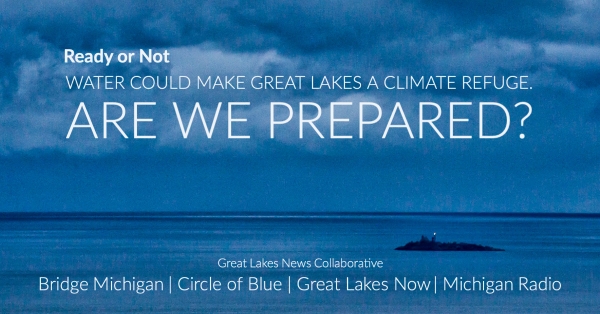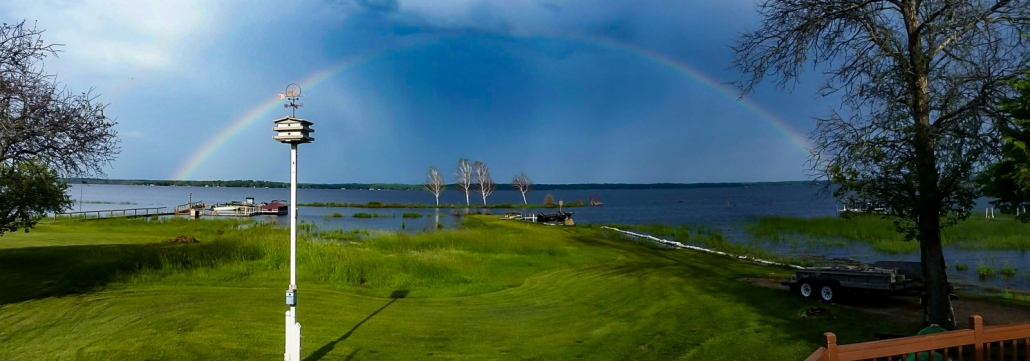
Mike Bach spent around $8,000 to install a system of pipes and pumps to stop his late father’s home in Michigan’s Upper Peninsula from flooding. Photo Courtesy Mike Bach
Key Takeaways
- Access to ample water supplies could make Michigan a climate refuge, but climate change is also disrupting the earth’s meteorological cycles. Which means more fierce Great Lakes region storms and more floods.
- Financially struggling families are typically unaware of flood risks. Even if they were aware, they usually don’t have the money to respond adequately.
- Wealthier residents living in highly desirable coastal areas can afford to spend large sums of money to adapt to the changing climate.
By Jane Johnston, Circle of Blue — April 27, 2021
[bctt tweet=”The tale of two families in Michigan illustrates the new normal caused by climate disruption. The human costs fall heaviest on the poor. #GreatLakesReadyorNot” username=”circleofblue”]
Access to ample water supplies could make Michigan a climate refuge. That scenario is attracting considerable attention in the Great Lakes State.
But climate change also is disrupting the earth’s meteorological cycles. Which means more fierce Great Lakes region storms and more floods.
The consequences are not evenly distributed. Or, in the words of Jeremy Porter, the head of research and development at First Street Foundation, a Brooklyn-based research group, flooding tells “two different stories.”
One of them, said Porter, belongs to financially struggling families who are unaware of flood risks. People like Michele Ivey. In September of 2020, Ivey and her siblings, Miki and Bryan, moved out of a two bedroom mobile home in Rochester Hills after the death of their father, and into a home just off of the St. Clair River in East China Township, northwest of Detroit.
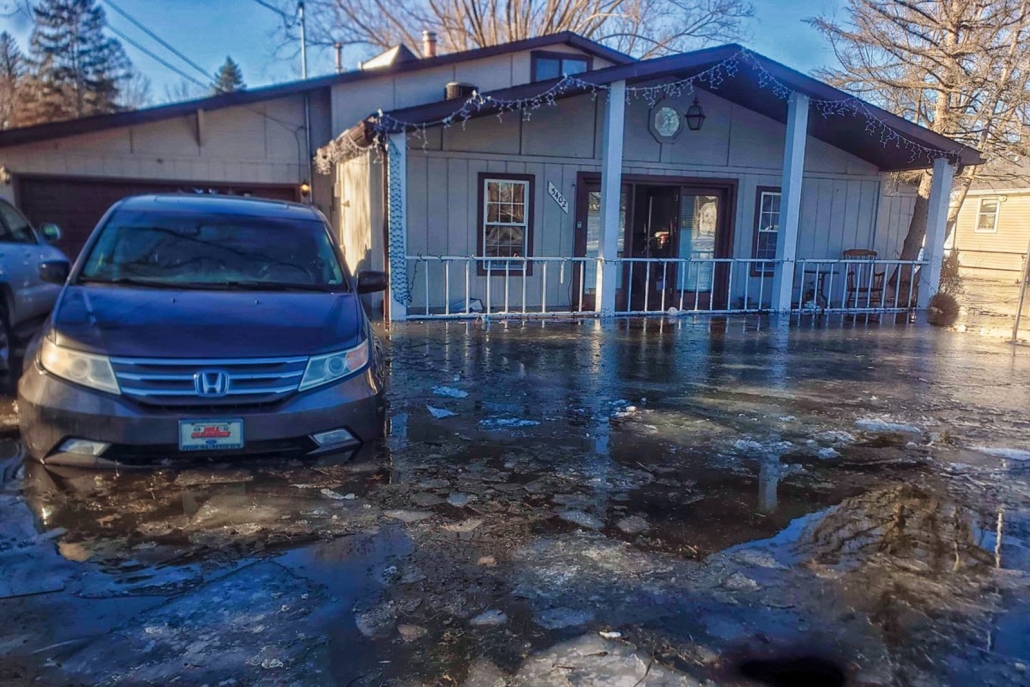
When ice impeded the flow of the St. Clair River in March, it flooded the Ivey’s home and forced them to move into a mobile home 50 miles away. Photo credit: Michele Ivey/Go Fund Me
The new home was large enough for four pets and their mother, who struggles with multiple sclerosis. But it was not as secure from flooding as they were told by the landlord, who assured Ivey, she said, that the only part of their home that would be affected by a flood would be the garage.
In February, though, ice impeded the flow of the St. Clair River, inundating the area, including the Iveys’ home. They struggled to get assistance from their landlord or the township. Left with no other option, the Iveys packed up what was left of their belongings and returned to the mobile home in Rochester Hills, nearly 50 miles away.
“The flood really uprooted my entire family,” Michele Ivey said. “We’re not fixing the place up, but we’re not going to leave the place trashed either. We’re not trying to be bad tenants. We just can’t live somewhere that’s unsafe.”
The second story, Porter said, applied to wealthier residents living in highly desirable coastal areas who can afford to spend large sums of money to adapt.
That’s the story of folks like Mike Bach, a 41-year-old nutrition specialist living on the shores of Little Bay de Noc along Lake Michigan’s southern shoreline in the Upper Peninsula.
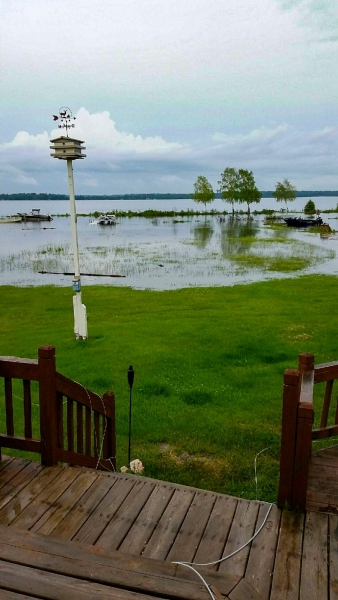
Mike Bach spent 1500 hours installing a system of pipes and pumps around his Little Bay de Noc home to stop flooding and erosion on the property. Photo Courtesy Mike Bach
Bach’s father bought the bayside home in 2010. After his death in 2015, Bach decided to keep the home in the family. But shortly after his father’s passing, Lake Michigan water levels began to rise, creating intermittent waves that flooded his home and garage on multiple occasions.
“There were times when I would have minnows swimming in my garage,” Bach told Circle of Blue, adding that once he walked out his front door into water up to his waist.
Bach spent around $8000 to install a system of drain tile pipes and pumps, along with a quarry stone barrier around his home. Since then, he said his house has been protected from so-called “seiche” waves and waters.
“I currently have no plans for selling, and hope to keep it in the family as long as possible,” he said. “It’s a beautiful place in the world and I am truly blessed to be here.”
This tale of two families illustrates the new normal caused by climate disruption. The human costs fall heaviest on the poor. And while responsibility for footing the financial bill is debated throughout Michigan, the burden typically falls on individual homeowners.
The biggest problem with that, Porter said, is that many homeowners don’t know they’re at risk and don’t have the means to respond adequately if they did.
Comprehensive flood risk data is available, Porter said. But homeowners do not typically know where to find it. “Mortgage companies, institutional investors, lenders, they all have access to that data,” Porter told Circle of Blue. “The problem is that regular homeowners don’t know what that flood risk looks like.”
To fix that problem Porter and the First Street Foundation developed Flood Factor, a free online database that enables Americans to find their property’s risk of flooding, and understand why flood risk is increasing.
[bctt tweet=”“The problem is that regular homeowners don’t know what that flood risk looks like.” — Jeremy Porter, the head of research and development at First Street Foundation. #GreatLakesReadyorNot ” username=”circleofblue”]
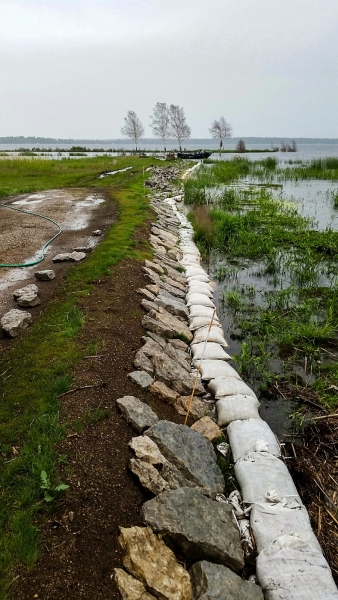
Mike Bach installed 100 tons of quarry stone and filled over 700 sandbags to prevent erosion on his lakeside property. Photo Courtesy Mike Bach
“The main thing for places that don’t know what their flood risk is, is to be informed,” Porter said. From there, homeowners can take a number of steps to mitigate flood risk. They range from easy steps — cleaning gutters or sandbagging during heavy rain – to more expensive solutions, like raising or relocating homes.
The Iveys never had a chance to protect themselves. “We asked about flood risks,” Michele said. She added that if they had known water could end up inside their home, they would never have moved in.
The family survives on disability checks and can’t afford repairs. They set up a GoFundMe page. Michele said the first few weeks after the flood left them financially and emotionally drained.
“It’s sad because it’s a beautiful house,” Ivey said of the East China Township home. “It just felt like we barely got in there. Then all of a sudden we got to go right back to where we were trying to escape.”
Ready or not — the Great Lakes as a climate refuge
The Great Lakes region is frequently touted as one of the most climate-resilient places in the U.S., in no small part because of its enviable water resources. But climate change threatens water quality, availability, and aging water infrastructure by exposing existing vulnerabilities and creating new ones. In this series, members of the Great Lakes News Collaborative explore what it may take to prepare the Great Lakes region for the future climatologists say we can expect.
Funded by the Charles Stewart Mott Foundation, the collaborative’s four nonprofit newsrooms — Bridge Michigan, Circle of Blue, Great Lakes Now at DPTV and Michigan Radio — aim to elevate discussion, amplify the voice of Michigan residents and produce action that protects the region’s waters for future generations. While Mott provides financial support, our public service journalism is produced independently.
Jane is a Communications Associate for Circle of Blue. She writes The Stream and has covered domestic and international water issues for Circle of Blue. She is a recent graduate of Grand Valley State University, where she studied Multimedia Journalism and Women, Gender and Sexuality Studies. During her time at Grand Valley, she was the host of the Community Service Learning Center podcast Be the Change. Currently based in Grand Rapids, Michigan, Jane enjoys listening to music, reading and spending time outdoors.

